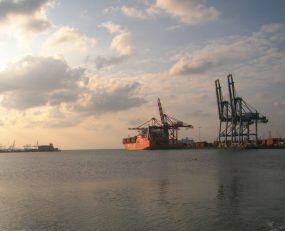
Since Eritrea’s independence in 1993 and therefore the loss of Ethiopia’s coastal access, the country has been developing its transport routes back to the coast. In recent years, it has been utilising investment schemes such as the Chinese Belt and Road Initiative (BRI) and more recently the African Development Bank to build this infrastructure, whilst making use of its relationship with Djibouti to secure access to the sea.
For many years now, Ethiopia has set out ambitions to become a global manufacturing hub. More export revenue can be made from manufactured goods such as clothing garments, compared to its current major exports such as coffee and legume. To become a more important player in global trade, the landlocked nation of Ethiopia needs port access. Over the past 20 years the country has been building its way to the coast.
The Chinese funded construction of industrial parks is one way the country is moving towards manufacturing goods for export. The new constructions can be found along the Chinese built highways and the rail line, linking capital Addis Ababa to the port of Doraleh, an extension of the port of Djibouti. The Hawassa Industrial Park, which is solely for the manufacture of textiles and apparel, has helped the country earn $38m in export revenues in the last two years.
The construction of transport links to carry goods is vital to the country succeeding in its plans. Over the last two decades Chinese investment has meant road mileage has increased by 124,000 km to 150,000 km in total. In June 2019, a new 220 km road was opened connecting Ethiopia and Djibouti, which has more than halved journey time from 10 hours to four hours. Rail connections to Djibouti have also greatly developed with over 750 km of electrified rail line connecting Addis Ababa to port of Doraleh.
“This railway is related to industrialisation, urbanisation and development with nine Ethiopian industrial parks out of 15 being located along the rail line. So, this is not just a line, this is a corridor and we do believe this corridor can be a game changer for economic development,” said Tan Jian, Chinese Ambassador to Ethiopia.
In March 2018, DP World ceased operations at the port of Djibouti after being forced out. Ethiopia signed a deal to take a stake in the port creating inter-dependency. Djibouti needs Ethiopia’s investment and traffic as much as Ethiopia needs the access.
Ethiopia’s desire to become a hub of manufacturing can be attributed to the need for higher export revenues but to do this is requires constant and secure access to the sea. In 2018, the country acquired land from the island of Lamu, Kenya, to set up a logistics facility, as well as signing a deal to support the development of the port of Sudan, in turn for reduced port fees. More recently, the government of Ethiopia has signed an agreement with African Development Bank (ADF) for a $98m contribution to a $255m project, where the money will go towards the first 60 km stretch of an expressway from the towns Adama to Awash.
The positive and productive relationship with Djibouti and other neighbouring nations is rare and is key to both nation’s economic growth. The Horn of Africa is notoriously a volatile area and with its key strategic access causing many conflicts the Ethiopia-Djibouti relations are vital for internal African trade.
To realise its ambitions of becoming a manufacturing hub Ethiopia has made vast ground with its developments towards the Djibouti’s coastline. The access and use of the port of Djibouti is paramount to meeting Ethiopia’s aims of becoming a player in global manufacturing. The port currently handles 95% of Ethiopia’s imports and exports.
Ethiopia’s ambitions to become a manufacturing hub have spurred the developments for port access. Through huge BRI investments, its infrastructure has improved enabling general economic and industrial growth as well as helping it secure faster and more efficient routes for trade; whether that be through Kenya, Sudan or most importantly Djibouti.
The move to manufacturing is undoubtedly to create more revenues from its exports. The BRI is a positive scheme if adhered to, however many African countries have found themselves further in debt and struggled to keep up with the repayments. What is most important for Ethiopia is making sure the investments made using Chinese money are fruitful enough to make the repayments.
The investment in infrastructure has been key to Ethiopia’s recent economic growth and could power expansion in its logistics market in the future. Its ranking in the Agility Emerging Markets Logistics Index currently stands at 41st of 50 developing countries. Reforms and further incentivised international investment have generated growth, however its bureaucracy and regulatory burdens are holding it back somewhat. The country has potential and by diversifying it is moving it the right direction. Its logistics sector will be able to capitalise on this diversification. For example, as more manufacturing begins to take place, the need for contract logistics provision will increase. Its freight forwarding market is also expected to grow rapidly as it looks to increase exports.
The investments made do not come without risk, but the funds pumped into its transport infrastructure, if coupled with provision of high quality logistics services, give Ethiopia the chance to power its economic growth in the years to come.
Source: Transport Intelligence, August 20, 2019
Author: Holly Stewart